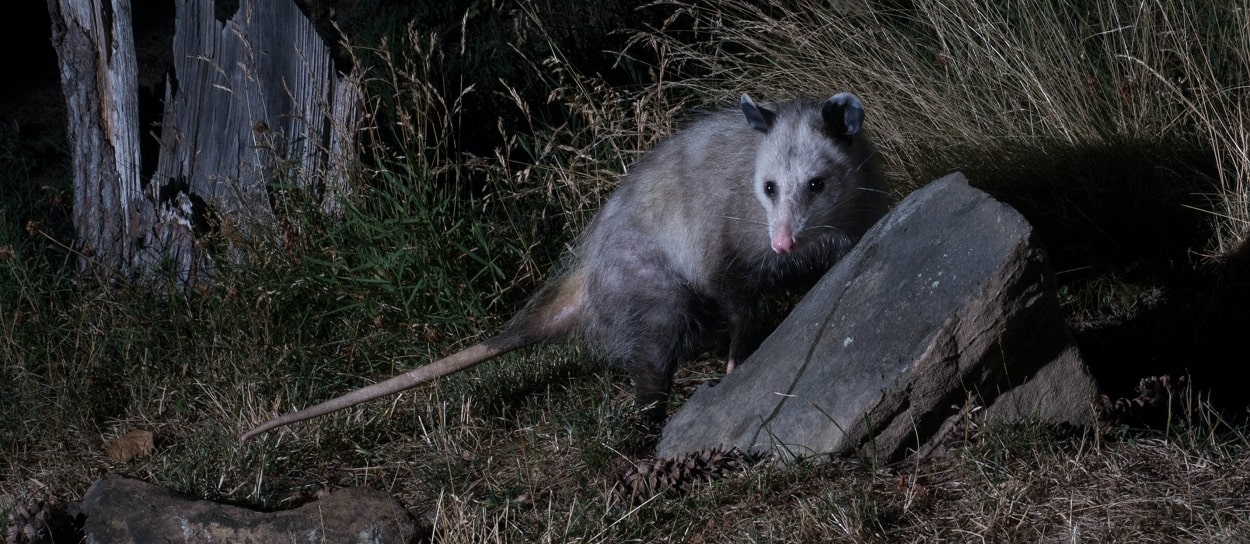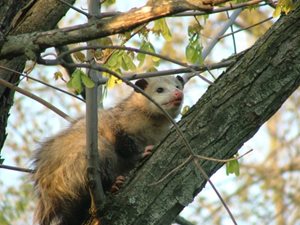

It’s common to have opossums in the neighborhood, even if you live in a relatively populated area. Opossums are adaptable critters. As urbanization pushes them out of their natural habitats, they’ve moved into suburban areas where they can easily find a steady source of food, fewer predators, and safe shelter.
In their natural habitat, tree hollows are one of the most common places for opossums to nest. Opossums are agile and excellent climbers because their tails are prehensile and aid in balance and gripping branches. Opossums get onto home roofs by jumping from overhanging branches. Once on your roof, they will look for vulnerabilities they can use to get into your attic. Because of how common it’s becoming to have an opossum in the attic, your best defense is to engage professionals to perform exclusion and removal services.
Signs of an Opossum Infestation
When an animal is in your roof, the first thing to do is identify the culprit. Opossums are cat-sized mammals. Typically, they are grayish brown with lighter fur on their face and belly. They have pointy snouts, pink noses, and dark, beady eyes. Their tails are hairless and can be as long as their entire bodies. When their young, called joeys, are old enough to live outside of their mothers’ sacs, mothers carry them around on their backs while foraging for food.
Opossums are nocturnal. But even though you might never see them, you will know you have an opossum infestation by some telltale signs:
- They are vocal animals that make unusual noises to communicate. It would be common to hear opossum hissing sounds. They are also known to grunt, screech, and make clicking sounds.
- Once on your roof, opossums will make scratching, scampering, and rustling sounds at night when they are awake and active.
- Opossums have scent glands that give off a distinctively musky smell which they use to mark their territory. The smell of opossum feces and urine will also be present.
- If you find a nest made of leaves, grass, paper, and other debris in a secluded area of your attic, you have an opossum nest.
- Opossums leave droppings that are about one to two inches in length, smooth on the sides and curled on the ends. Older feces can be covered in a white or yellowish mold.
- Torn insulation and gnawed wood and wires are other common signs as opossums have sharp teeth.
How Do Opossums Get on the Roof?
Many people ask, can opossums climb? Opossums are excellent climbers. Their feet have sharp claws for gripping, and they use their tails for balance. They use these climbing skills to hop onto a roof from nearby trees, bushes, fences, or power lines. Chain-link and wooden fences are a cinch for them to scamper up and over. Opossums can even climb up certain types of textured home siding.
Why Are There Opossums on the Roof?
Because human expansion has forced them out of their habitat, opossums seek shelter in comparable places. While they can build their dens closer to the ground in rock piles and brush, you have an opossum in the attic because it mimics the dens some make high in tree hollows. An opossum in the house usually means it has a consistent source of food nearby, and that is likely why it is on your roof.
Do Opossums on the Roof Cause Damage?
An opossum has one goal while on your roof: to gain entry into the attic. Looking for a dry, warm, and predator-free place to raise its young, an opossum will cause damage to roof shingles, soffits, and wood to get inside.
Once within an attic, it will tear insulation and gnaw on wood and electrical wires, which causes costly damage and can put you at risk of a fire. In addition, the accumulation of feces and urine will compromise insulation and damage wood.
Are Opossums Dangerous?
Like many nuisance wildlife, opossums carry parasites such as mites, lice, and ticks. They can also spread diseases to humans and pets, such as leptospirosis, which causes flu-like symptoms but can lead to organ damage; tuberculosis, a disease of the lungs; and salmonella, which causes abdominal cramps and diarrhea.
Although nonconfrontational, opossums can become aggressive when cornered, which could pose a danger to pets out in the yard. Opossums can also spread their parasites to pets. Opossum feces may carry equine protozoal myeloencephalitis, a highly infectious disease that attacks the nervous systems of horses.
How to Prevent Opossums on the Roof
To lessen the chance of opossum problems on your property, homeowners can take the following steps:
- Trim tree limbs and bushes that touch walls or hang over the roof to limit their access to your roof.
- Wrap trees near the house with two-foot-high metal sheeting to prevent climbing.
- Remove ivy and other vines from the side of the house.
- Attach slippery metal flashing near the roofline to take away easy access.
- Seal openings into attics made by squirrels or raccoons.
- Keep trash cans tightly sealed.
- Bring pet food indoors.
- Clear your yard of extra brush and other natural debris.
- Add mesh and covers to chimneys and vents.
Sometimes, no matter how much care you take to prevent an opossum infestation, there are times when opossums are so determined that they gain entry despite your efforts. Call Critter Control for the professional removal of these and other nuisance wildlife invasions. They can also review exclusion services with you to prevent any future infestation.
How to Get Rid of Opossums on the Roof
Many homeowners like to try to do things on their own before calling in professional services. If you are one of those people, using Google will bring up many products that seem like they have the potential to get rid of opossums. These products include:
- Ultrasonic pest repellers.
- Sachets with scents such as peppermint or lavender that opossums find unpleasant.
- Urine from predators.
- Motion-activated lights and sounds.
These products have limited value as they can’t compete with determined opossums. Opossums will become used to lights and scents, and they are too smart to think these items pose a real danger to them.
One warning is that it is a dangerous idea to try to trap and relocate an opossum. In addition to it becoming aggressive when trapped, it is illegal in most states to relocate an opossum, and it puts the opossum’s well-being in danger.
The one overlooked aspect of how to get rid of opossums on your own is that cleaning up after their urine and feces is the primary way the diseases they carry can be transmitted.
Opossum Removal Services
When you call Critter Control, you’ll have a highly trained and experienced professional who can humanely and safely remove opossums from your attic. Critter Control arrives with the proper tools, methods, and knowledge to do the job right. Critter Control also provides exclusion and restoration services. Your attic will be sanitized and restored to its original condition.
Call Critter Control today at (205) 286-6623 to learn more and get started.
Get them out.
Keep them out.®
Experiencing a wildlife or pest issue? We can help! Complete this form and your local Critter Control® office will contact you to assist.
- How to Identify Opossum Noises
- Are Opossums Dangerous?
- Opossum Diet
- Opossum Droppings
- Opossum Playing Dead
- Opossum Tracks
- Opossums and Rabies
- What Does an Opossum Look Like?
- Opossum Babies: Identification & Concerns
- Opossums in the Attic
- Opossums in the Day
- Opossums in the Walls – Prevention & Removal
- Opossums and Ticks: Do Opossums Eat Ticks?
- Do Opossums Hibernate in the Winter?
- Opossum Under Your House, Deck, or Shed